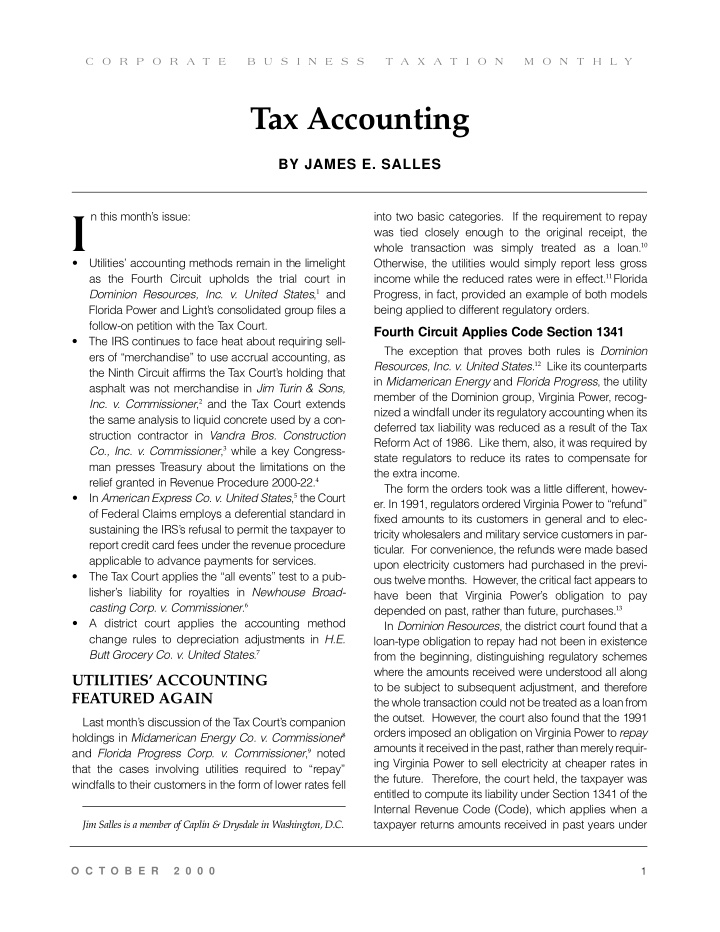



C O R P O R A T E B U S I N E S S T A X A T I O N M O N T H L Y Tax Accounting BY JAMES E. S A L L E S n this month’s issue: into two basic categories. If the re q u i rement to re p a y I was tied closely enough to the original receipt, the whole transaction was simply treated as a loan. 1 0 • Utilities’ accounting methods remain in the limelight O t h e rwise, the utilities would simply re p o rt less gro s s . 11 F as the Fourth Circuit upholds the trial court in income while the reduced rates were in eff e c t l o r i d a Dominion Resources, Inc. v. United States , 1 a n d P ro g ress, in fact, provided an example of both models Florida Power and Light’s consolidated group files a being applied to diff e rent re g u l a t o ry orders. follow-on petition with the T ax Court . F o u rth Circuit Applies Code Section 1341 • The IRS continues to face heat about requiring sell- The exception that proves both rules is D o m i n i o n ers of “merchandise” to use accrual accounting, as 2 Like its counterpart rces, Inc. v. United States. 1 R e s o u s the Ninth Circuit aff i rms the Tax Court ’s holding that in Midamerican Energ y and Florida Pro g re s s , the utility asphalt was not merchandise in Jim Turin & Sons, member of the Dominion group, Vi rginia Power, re c o g- Inc. v. Commissioner , 2 and the Tax Court extends nized a windfall under its re g u l a t o ry accounting when its the same analysis to liquid concrete used by a con- d e f e rred tax liability was reduced as a result of the T a x s t ruction contractor in Vandra Bros. Constru c t i o n R e f o rm Act of 1986. Like them, also, it was re q u i red by Co., Inc. v. Commissioner , 3 while a key Congre s s - state regulators to reduce its rates to compensate for man presses Tre a s u ry about the limitations on the the extra income. relief granted in Revenue Pro c e d u re 2000-22. 4 The form the orders took was a little diff e rent, howev- In American Express Co. v. United States , 5 the Court • e r. In 1991, regulators ord e red Vi rginia Power to “re f u n d ” of Federal Claims employs a deferential standard in fixed amounts to its customers in general and to elec- sustaining the IRS’s refusal to permit the taxpayer to tricity wholesalers and military service customers in par- re p o rt credit card fees under the revenue pro c e d u re t i c u l a r. For convenience, the refunds were made based applicable to advance payments for serv i c e s . upon electricity customers had purchased in the pre v i- • The Tax Court applies the “all events” test to a pub- ous twelve months. However, the critical fact appears to l i s h e r’s liability for royalties in Newhouse Bro a d - have been that Vi rginia Power’s obligation to pay casting Corp. v. Commissioner . 6 depended on past, rather than future, purc h a s e s . 1 3 • A district court applies the accounting method In Dominion Resourc s , the district court found that a e change rules to depreciation adjustments in H . E . loan-type obligation to repay had not been in existence ry Co. v. United States . 7 Butt Gro c e f rom the beginning, distinguishing re g u l a t o ry schemes w h e re the amounts received were understood all along U T I L I T I E S ’ ACCOUNTING to be subject to subsequent adjustment, and there f o re F E ATURED AGAIN the whole transaction could not be treated as a loan fro m the outset. However, the court also found that the 1991 Last month’s discussion of the Tax Court ’s companion o rders imposed an obligation on Vi rginia Power to re p a y holdings in Midamerican Energy Co. v. Commissioner 8 amounts it received in the past, rather than merely re q u i r- ress Corp. v. Commissioner , 9 n and Florida Pro g o t e d ing Vi rginia Power to sell electricity at cheaper rates in that the cases involving utilities re q u i red to “re p a y ” the future. There f o re, the court held, the taxpayer was windfalls to their customers in the form of lower rates fell entitled to compute its liability under Section 1341 of the I n t e rnal Revenue Code (Code), which applies when a taxpayer re t u rns amounts received in past years under Jim Salles is a member of Caplin & Drysdale in Washington, D.C. O C T O B E R 2 0 0 0 1
Recommend
More recommend